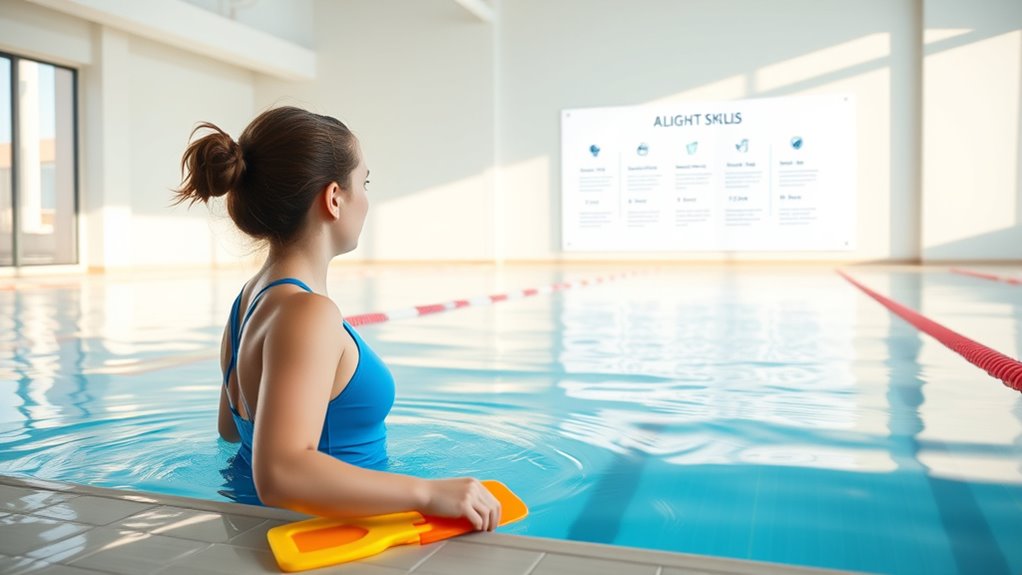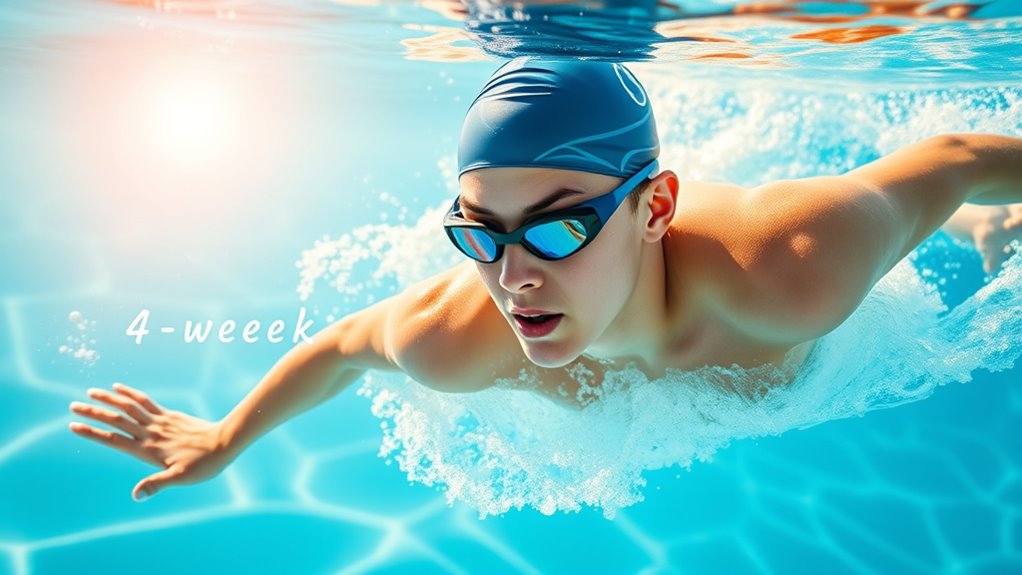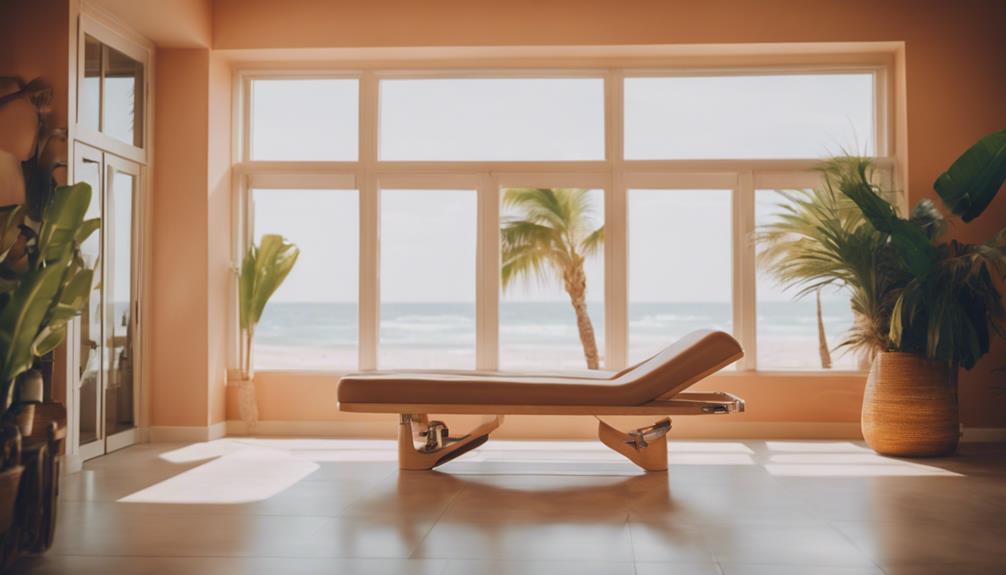A 4-week beginner swim workout plan helps you build confidence and endurance gradually. Start with short sessions focusing on basic techniques like breaststroke, body position, and breathing. Use simple drills, mix in some kickboards or fins, and increase your swim time each week. Stick to a consistent routine, listen to your body, and follow this progression to improve form and stamina. Keep going, and you’ll discover even more tips to enhance your swimming skills.
Key Takeaways
- Start with short, focused sessions emphasizing breaststroke, body position, and breathing to build confidence and technique.
- Gradually increase swim duration and laps weekly, adding drills like kickboard exercises to improve efficiency.
- Incorporate rest periods between sets and prioritize relaxed, smooth movements to prevent fatigue.
- Use essential gear such as goggles, swim cap, and fins to enhance comfort and refine technique.
- Track progress with waterproof timers and adjust intensity based on comfort to ensure sustainable improvement.

Starting a swimming routine can feel intimidating, but a beginner swim workout plan makes it manageable and enjoyable. Whether you’re stepping into the pool for the first time or trying to build confidence in the water, a structured plan helps keep you focused and motivated. The key is to start with the basics, including mastering the breaststroke technique, which is often recommended for beginners because it’s slow, controlled, and easier to learn. As you practice, pay attention to your body position, arm movements, and breathing patterns. Focus on keeping your movements smooth and relaxed, which conserves energy and reduces fatigue. Watching tutorials or working with a coach can significantly improve your breaststroke form and help you avoid developing bad habits early on.
Starting a swim routine? Focus on mastering breaststroke for confidence and control.
Equally important is having the right swimming gear essentials. Invest in a comfortable, well-fitting swimsuit designed for training, a pair of goggles that don’t leak and offer clear vision underwater, and a swim cap to reduce drag and protect your hair. Using fins or kickboards can also assist during your drills, helping you isolate specific muscles and refine your technique. A waterproof stopwatch or a pool timer can help you track your laps and rest periods, keeping your workouts structured and effective. Remember, quality gear isn’t just about comfort; it’s about making your swim sessions safer and more enjoyable, encouraging you to stick with your routine over the long term. Incorporating water-resistant timing devices can further enhance your workout tracking and motivation.
In your first week, aim for short sessions, around 20 to 30 minutes, focusing on form rather than speed. Alternate between swimming and resting, practicing your breaststroke and other gentle strokes like backstroke or sidestroke to build endurance and muscle memory. As you progress into the second week, gradually increase your swim time and incorporate simple drills to improve your technique, such as focusing on arm pulls or kick efficiency. The third week should see you adding more laps and experimenting with breathing patterns to increase your comfort in the water. By the fourth week, you’ll likely notice improvements in your stamina, coordination, and confidence.
Remember to stay consistent and listen to your body. It’s normal to feel tired or sore at first, but with proper rest and a gradual increase in intensity, you’ll develop a solid foundation. Keep practicing your breaststroke technique and make sure your swimming gear essentials are in good shape. Before long, swimming will feel less like a challenge and more like a rewarding part of your regular fitness routine.
Frequently Asked Questions
What Equipment Is Necessary for Beginner Swim Workouts?
For beginner swim workouts, you mainly need basic swimming gear like goggles, a swim cap, and a comfortable swimsuit. These items help you see clearly, protect your hair, and stay streamlined. Remember to follow pool etiquette by showering before entering and avoiding loud noises. Focus on staying relaxed and using proper technique. With this gear and respectful behavior, you’ll build confidence and enjoy your swimming journey.
How Should I Adjust Workouts for Personal Fitness Levels?
You should tailor your workouts based on your fitness assessment, listening to your body, and setting realistic goals. Incorporate personalized training by adjusting swim distances, rest times, and intensity levels to match your current abilities. Progress gradually, focusing on consistency and technique. Remember, improving your fitness involves patience and adaptation, so regularly reevaluate your progress, and don’t hesitate to modify your plan to stay challenged yet comfortable.
What Safety Precautions Should I Follow While Swimming?
You should always prioritize pool safety by checking water temperature to guarantee it’s comfortable and safe, ideally between 78-82°F. Follow safety rules, like no running around the pool and avoiding diving in shallow areas. Always swim with a buddy, stay within your skill level, and use proper safety gear if needed. Being aware of your surroundings and listening to lifeguards helps prevent accidents and keeps your swimming experience safe.
How Can I Improve My Breathing Techniques?
Imagine your breath as a steady drumbeat guiding your swim. To improve your breathing techniques, focus on breathing exercises outside the pool to strengthen breath control. Practice exhaling slowly underwater and inhaling smoothly through your mouth when turning your head. Incorporate rhythmic breathing patterns into your swim, syncing your breath with your strokes. This steady rhythm helps conserve energy and boosts your confidence in the water.
When Should I Progress to More Advanced Swim Routines?
You should progress to more advanced swim routines once you feel confident with your stroke techniques and can maintain a steady swim pace without losing form or breath control. Look for improvements in your breathing efficiency and comfort in the water. When your current workout feels too easy and you’re ready to challenge yourself, it’s time to gradually add new drills or increase intensity, ensuring you build skill safely and enjoyably.
Conclusion
By the end of these four weeks, you’ll find yourself gliding through the water like a graceful dolphin, confidence soaring with each stroke. Remember, every splash and splashy attempt is a step closer to mastering the art of swimming. Embrace the journey, stay persistent, and soon you’ll be weaving through the pool with the ease of a fish in its home. Your aquatic adventure awaits—dive in and let your new skills shine!










